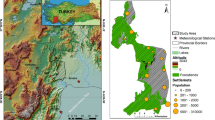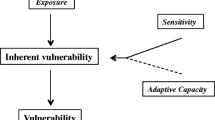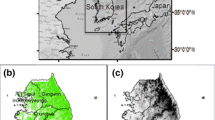Abstract
Forests are subjected to stress from climatic and non-climatic sources. In this study, we have reported the results of inherent, as well as climate change driven vulnerability assessments for Indian forests. To assess inherent vulnerability of forests under current climate, we have used four indicators, namely biological richness, disturbance index, canopy cover, and slope. The assessment is presented as spatial profile of inherent vulnerability in low, medium, high and very high vulnerability classes. Fourty percent forest grid points in India show high or very high inherent vulnerability. Plantation forests show higher inherent vulnerability than natural forests. We assess the climate change driven vulnerability by combining the results of inherent vulnerability assessment with the climate change impact projections simulated by the Integrated Biosphere Simulator dynamic global vegetation model. While 46% forest grid points show high, very high, or extremely high vulnerability under future climate in the short term (2030s) under both representative concentration pathways 4.5 and 8.5, such grid points are 49 and 54%, respectively, in the long term (2080s). Generally, forests in the higher rainfall zones show lower vulnerability as compared to drier forests under future climate. Minimizing anthropogenic disturbance and conserving biodiversity can potentially reduce forest vulnerability under climate change. For disturbed forests and plantations, adaptive management aimed at forest restoration is necessary to build long-term resilience.


Similar content being viewed by others
References
Bengtsson J, Nilsson SG, Franc A et al. (2000) Biodiversity, disturbance, ecosystem function and management of European forests. Forest Ecol Manag 132:39–50
Bonan GB (2008) Forests and climate change: forcings, feedbacks and the climate benefits of forests. Science 320(5882):1444–1449
Chaturvedi RK, Ranjith G, Jayaraman M et al. (2011) Impact of climate change on Indian forests: a dynamic vegetation modeling approach. Mitig Adapt Strat Global Change 16(2):119–142
Coops NC, Wulder MA, Waring RH (2012) Modelling lodgepole and jack pine vulnerability to mountain pine beetle expansion into the Western Canadian boreal forest. Forest Ecol Manag 274:161–171
Cramer W, Bondeau A, Schaphoff S et al. (2004) Tropical forests and the global carbon cycle: impacts of atmospheric carbon dioxide, climate change and rate of deforestation. Phil Trans Roy Soc Lond B 359:331–343
Cutter SL, Barnes L, Berry M et al. (2008) A place-based model for understanding community resilience to natural disasters. Global Environ Change 18:598–606
De Lange HJ, Sala S, Vighi M et al. (2010) Ecological vulnerability in risk assessment–A review and perspectives. Science Total Environ 408:3871–3879
Downing TE, Butterfield R, Cohen S et al. (2001) Climate change vulnerability: linking impacts and adaptation. University of Oxford, Oxford
Evangelista PH, Kumar S, Stohlgren TJ et al. (2011) Assessing forest vulnerability and the potential distribution of Pine beetle under current and future climate scenarios in the Interior West of the US. Forest Ecol Manag 262:307–316
FAO (2013) Climate change guidelines for forest managers. FAO Forestry Paper No. 172. Rome, Food and Agriculture Organization of the United Nations
Fischlin AM, Ayres D, Karnosky S et al. (2009) Future environmental impacts and vulnerabilities. In: Seppala R, Buck A, Katila P (eds) Adaptation of forest and people to climate change: a global assessment report, IUFRO World Series Vol. 22, pp 53–100.
García-López JM, Allué C (2012) A phytoclimatic-based indicator for assessing the inherent responsitivity of the European forests to climate change. Ecol Indic 18:73–81
Geist HJ, Lambin EF (2002) Proximate causes and underlying driving forces of tropical deforestation. Bioscience 52:143–150
Gibson L, Lee TM, Koh LP et al. (2011) Primary forests are irreplaceable for sustaining tropical biodiversity. Nature 478(7369):378–381
IPCC (2012) Managing the Risks of Extreme Events and Disasters to Advance Climate Change Adaptation. A Special Report of Working Groups I and II of the Intergovernmental Panel on Climate Change. In: Field CB, Barros V, Stocker TF, Qin D, Dokken DJ, Ebi KL, Mastrandrea MD, Mach KJ, Plattner GK, Allen SK, Tignor M, Midgley PM (eds). Cambridge University Press, Cambridge, New York, p 582
IPCC (2013) Climate Change 2013: The Physical Science Basis. Contribution of Working Group I to the Fifth Assessment Report of the Intergovernmental Panel on Climate Change. In: Stocker TF, Qin D, Plattner GK, Tignor M, Allen SK, Boschung J, Nauels A, Xia Y, Bex V, Midgley PM (eds). Cambridge University Press, Cambridge, New York, p 1535
IPCC (2014) Field CB, Barros VR, Mach KJ et al. Technical summary. Climate Change 2014: Impacts, Adaptation, and Vulnerability. Part A: Global and Sectoral Aspects. Contribution of Working Group II to the Fifth Assessment Report of the Intergovernmental Panel on Climate Change. In: Field CB, Barros VR, Dokken DJ, Mach KJ, Mastrandrea MD, Bilir TE, Chatterjee M, Ebi KL, Estrada YO, Genova RC, Girma B, Kissel ES, Levy AN, MacCracken S, Mastrandrea PR, White LL (eds). Cambridge University Press, Cambridge, New York, p 35–94
ISFR (2013) State of Forest Report 2013. Forest Survey of India, Government of India, Dehradun
Lindner M, Maroschek M, Netherer S (2010) Climate change impacts, adaptive capacity, and vulnerability of European forest ecosystems. Forest Ecol Manag 259:698–709
Locatelli B, Kanninen M, Brockhaus M et al. (2008) Facing an uncertain future: How forests and people can adapt to climate change. Forest Perspectives no. 5 CIFOR, Bogor, Indonesia
Luers AL, Lobell DB, Sklar LS et al. (2003) A method for quantifying vulnerability, applied to the agricultural system of the Yaqui Valley, Mexico. Global Environ Change 13:255–267
Malhi Y, Roberts JT, Betts RA et al. (2008) Climate change, deforestation, and the fate of the Amazon. Science 319:169–172
Malhi Y, Aragão LEOC, Galbraith D et al. (2009) Exploring the likelihood and mechanism of a climate-change-induced dieback of the Amazon rainforest. Proceedings of the National Academy of Sciences of the United States of America. http://www.pnas.org/content/early/2009/02/12/0804619106.full.pdf+html?sid=3978dfb7-646f-4d85-a9b8-e373ca183a9c
Millar CI, Stephenson NL, Stephens SL (2007) Climate change and forests of the future: managing in the fcae of uncertainty. Ecol Appl 17:2145–2151
Metzger MJ, Rounsevell MDA, Acosta-Michlik L et al. (2006) The vulnerability of ecosystem services to land use change. Agric Ecosyst Environ 114:69–85
Murthy IK, Tiwari R, Ravindranath NH (2011) Climate change and forests in India: adaptation opportunities and challenges. Mitig Adapt Strat Global Change 16:161–175
Niemelä J (1999) Management in relation to disturbance in boreal forest. Forest Ecol Manag 115:127–134
Nitschke CR, Innes JL (2008) Integrating climate change into forest management in South-central British Columbia: an assessment of landscape vulnerability and development of a climate-smart framework. Forest Ecol Manag 256:313–327
Noss RF (1999) Assessing and monitoring forest biodiversity: a suggested framework and indicators. Forest Ecol Manag 115:135–146
Pasho E, Camarero JJ, de Luis M et al. (2011) Impacts of drought at different time scales on forest growth across a wide climatic gradient in north-eastern Spain. Agric Forest Meteorol 151:1800–1811
Payn T, Carnus JM, Smith PF et al. (2015) Changes in planted forests and future global implications. Forest Ecol Manag 352:57–67
Polsky C, Neff R, Yarnal B (2007) Building comparable global change vulnerability assessments: the vulnerability-scoping diagram. Global Environ Change 17:472–485
Ranjith G, Jayaraman M, Swarnim S et al. (2011) Impact of climate change at species level: a case study of teak in India. Mitig Adapt Strat Global Change 16:199–209
Ravindranath NH, Joshi NV, Sukumar R (2006) Impact of climate change on forests in India. Curr Sci 90(3):354–361
Ravindranath NH, Rao S, Sharma N et al. (2011) Climate change vulnerability profile for North East India. Curr Sci 101(3):384–394
Ribot J (2011) Vulnerability before adaption: towards transformative climate action. Global Environ Change 21:1160–1162
Roy PS, Kushwaha SPS, Murthy MSR et al. (2012) Biodiversity characterization at landscape level: national assessment. Indian Institute of Remote Sensing, Dehradun, p 140. ISBN 81-901418-8-0
Saaty TL (2008) Decision making with the analytic hierarchy process. Int J Serv Sci 1(1):83–98
Sharma J, Chaturvedi RK, Bala G et al. (2013) Challenges in vulnerability assessment of forests under climate change. Carbon Manag 4(4):403–411
Sharma J, Upgupta S, Kumar R et al. (2015) Assessment of inherent vulnerability of forests at landscape level: a case study from Western Ghats in India. Mitig Adapt Strat Global Change. doi: 10.1007/s11027-015-9659-7
Sharma J (2015) Vulnerability of forests to climatic and non-climatic stressors: a multi scale assessment for Indian forests. Dissertation, Indian Institute of Science
Singh MP, Bhojvaid PP, de Jong W et al. (2015) Forest transition and socio-economic development in India and their implications for forest transition theory. Forest Policy Econ. doi: 10.1016/j.forpol.2015.10.013
Thompson I, Mackey B, McNulty S et al. (2009) Forest Resilience, Biodiversity, and Climate Change. A synthesis of the biodiversity/resilience/stability relationship in forest ecosystems. Secretariat of the Convention on Biological Diversity, Montreal. Technical Series no. 43, p 67
Upgupta S, Sharma J, Jayaraman M et al. (2015) Climate change impact and vulnerability assessment of forests in the Indian Western Himalayan region: a case study of Himachal Pradesh, India. Clim Risk Manag 10:63–76
Acknowledgements
We thank the Norwegian Research Council and Center for International Climate and Environmental Research (CICERO) Oslo, Norway for supporting the research project on “Climate change and forests”. We thank FSI (Dehradun) and Indian Institute of Remote Sensing (IIRS, Dehradun) for providing spatial data on indicators. RKC would like to thank the Ministry of Environment and Forests, Government of India for supporting this study in the form of National Environmental Sciences Fellowship. Comments from two anonymous reviewers have helped in improving the manuscript. We are thankful to them.
Author information
Authors and Affiliations
Corresponding author
Ethics declarations
Conflict of Interest
The authors declare that they have no competing interests.
Electronic supplementary material
Rights and permissions
About this article
Cite this article
Sharma, J., Upgupta, S., Jayaraman, M. et al. Vulnerability of Forests in India: A National Scale Assessment. Environmental Management 60, 544–553 (2017). https://doi.org/10.1007/s00267-017-0894-4
Received:
Accepted:
Published:
Issue Date:
DOI: https://doi.org/10.1007/s00267-017-0894-4




